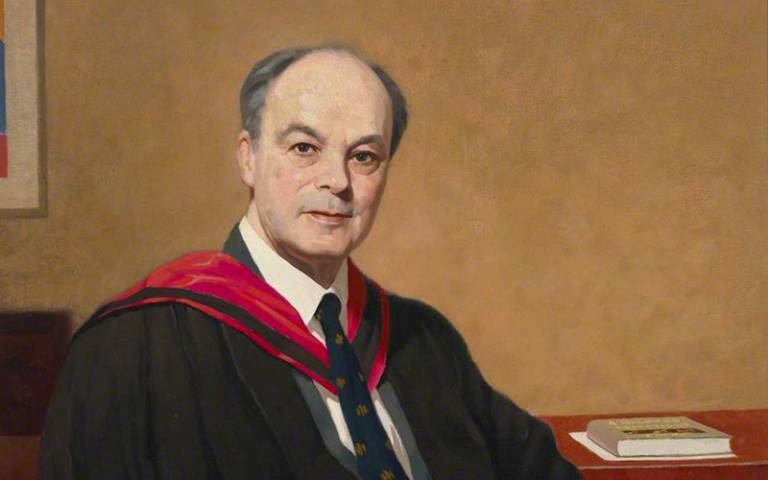In memory of Sir Peter Newsam (1928-2023)
2 January 2024
An appreciation of the former IOE Director who passed away in November 2023.

Professor Sir Peter Anthony Newsam (2 November 1928 – 16 November 2023), Director of IOE from 1989 to 1994, was one of the leading educational administrators of the postwar era (see Smithers 2023). His contributions to IOE helped to establish its outstanding position as a leading international centre for educational studies and research (McCulloch and Cowan 2018).
Newsam was born in Gloucester, the last of four sons born to first generation immigrant parents. His mother, Delphine Lelievre, was from France, while his father, William Newsam, was originally from Barbados and went on to become a circuit judge in India (Newsam 2014a, p.11). He spent his early years with his family in India before returning to England to go to boarding school. From the age of eight, he attended the Dragon School, a prep school in Oxford, for five years before going on to Clifton College in Bristol for a further five years, both fully described in his published memoir (Newsam 2014a, chapters 1-2).
The young Newsam was then called up for National Service, which lasted for two years before attending Queen’s College, Oxford, to study Law. He quickly changed course to take Politics, Philosophy and Economics and became increasingly attracted to philosophy. Leaving Oxford in 1952, and being successful in the Civil Service examination, he joined the Ministry of Munitions and then the Board of Trade, but decided to go into teaching, first at a prep school (Stout’s Hill) and then back at the Dragon School in Oxford. He took a Post Graduate Certificate of Education (PGCE) at the University of Oxford, doing his teaching practice at Oxford High School, and went on to teach history and English at Littlemore, a new grammar school close to Oxford (Newsam 2014a).
In 1962, Newsam left school teaching in favour of working in local education authorities (LEAs), from 1963-66 at the North Riding of Yorkshire, from 1966-70 at Cumberland, and then, from 1970-72 at the West Riding of Yorkshire where he worked closely with the renowned progressive Chief Education Officer, Sir Alec Clegg, about whom Newsam would later write an appreciation (Newsam 2008). Following these experiences, Newsam then moved to the Inner London Education Authority (ILEA), where he became Deputy Education Officer and, from 1977-82, its Chief Education Officer. This was a highly prominent national position and Newsam often found himself at odds with the trends of national politics, especially after the election of the Conservative government under Margaret Thatcher in 1979 (Newsam 2015b). Newsam was a strong believer in the common school and had played a significant role in bringing about the comprehensive re-organisation of London schools.
Nevertheless, after leaving the ILEA, the Conservative Home Secretary, Willie Whitelaw, appointed Newsam to chair the Commission for Racial Equality, after which he briefly served as Secretary of the Association of County Councils. He was knighted in 1987.
Newsam was appointed Director of IOE in 1989, aged sixty, following an initial approach on behalf of its search committee by Professor Basil Bernstein. At this stage, he was already a national figure and could look back on a distinguished and successful career in education. Yet this new post was not to be a quiet sinecure. The five year period that he spent as Director of the IOE was one of growth and further development, particularly in London, led by Newsam himself. Student numbers increased, as did the number of staff, including the professoriat. The PGCE system of teacher education was reconstructed, the management system was revised and departmental mergers took place alongside the emergence of many new smaller centres and units (see Aldrich and Woodin 2021, pp. 213-18). The growth of teaching and research represented a considerable achievement given that it was a period of increasing government surveillance and auditing as well as reduced funding – Newsam presciently noted that IOE would have to undergo a ‘cultural shift’ to handle these challenges (Aldrich and Woodin 2021, p. 236).
At the same time, IOE’s leadership position in teaching and research could lead to tensions with other bodies and with the Conservative government. This was especially the case as many of its leading figures had previously been leaders of the now-abolished ILEA, including Newsam himself and also his deputy and eventual successor as Director, Professor Peter Mortimore. Newsam remained alert to wider political forces and aimed to nurture amiable relationships across the political spectrum.
The most enduring legacy of Newsam’s period at IOE was no doubt in the building facilities at 20 Bedford Way. He initiated far-reaching and ambitious plans to develop the building further, including the entrance and nursery. Most of all, in difficult circumstances, the IOE library was greatly extended, and reopened by Princess Anne in 1993, and was ‘immediately acknowledged as the best education library in Europe’ (Aldrich and Woodin 2021, p. 222). Fittingly, it would become known as the Newsam Library.
After leaving IOE, Newsam maintained contacts, giving occasional talks and writing letters to the press where he expressed doubts about the direction of education policy which appeared to be undermining comprehensive schooling. He also produced a detailed memoir that provided fascinating clues to the warmth and humanity that underlay the career progress of the educational administrator (Newsam 2014a, 2014b).
Written by Professors Gary McCulloch and Tom Woodin.
Links
Image
Portrait of Professor Newsam (cropped) painted by Ying Sang Yang.
 Close
Close

